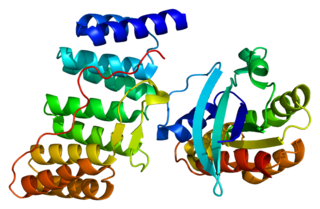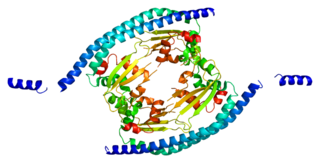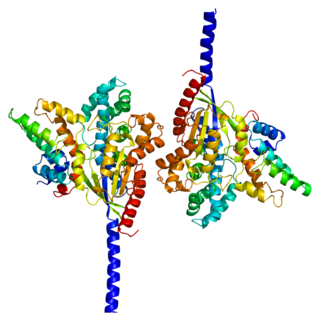Tenascin-R is a protein that in humans is encoded by the TNR gene. [5] [6] [7]
Tenascin-R is a protein that in humans is encoded by the TNR gene. [5] [6] [7]
Tenascin-R (TNR) is an extracellular matrix protein expressed primarily in the central nervous system. It is a member of the tenascin (TN) gene family, which includes 4 genes in mammals: TNC (or hexabrachion), TNX (TNXB), TNW (also known as TNN) and TNR. [8] [9] The genes are expressed in distinct tissues at different times during embryonic development and are present in adult tissues.[supplied by OMIM] [7]

Ras homolog gene family, member B, also known as RHOB, is a protein which in humans is encoded by the RHOB gene.

Caveolin-1 is a protein that in humans is encoded by the CAV1 gene.

Phosphatidylinositol 3-kinase regulatory subunit beta is an enzyme that in humans is encoded by the PIK3R2 gene.

Dual specificity mitogen-activated protein kinase kinase 6 also known as MAP kinase kinase 6 or MAPK/ERK kinase 6 is an enzyme that in humans is encoded by the MAP2K6 gene, on chromosome 17.

Ras-related C3 botulinum toxin substrate 3 (Rac3) is a G protein that in humans is encoded by the RAC3 gene. It is an important component of intracellular signalling pathways. Rac3 is a member of the Rac subfamily of the Rho family of small G proteins. Members of this superfamily appear to regulate a diverse array of cellular events, including the control of cell growth, cytoskeletal reorganization, and the activation of protein kinases.

Tenascin C (TN-C) is a glycoprotein that in humans is encoded by the TNC gene. It is expressed in the extracellular matrix of various tissues during development, disease or injury, and in restricted neurogenic areas of the central nervous system. Tenascin-C is the founding member of the tenascin protein family. In the embryo it is made by migrating cells like the neural crest; it is also abundant in developing tendons, bone and cartilage.

Protein SET, also known as Protein SET 1, is a protein that in humans is encoded by the SET gene.

Contactin 1, also known as CNTN1, is a protein which in humans is encoded by the CNTN1 gene.

G protein-coupled receptor kinase 5 is a member of the G protein-coupled receptor kinase subfamily of the Ser/Thr protein kinases, and is most highly similar to GRK4 and GRK6. The protein phosphorylates the activated forms of G protein-coupled receptors to regulate their signaling.

Myocyte-specific enhancer factor 2D is a protein that in humans is encoded by the MEF2D gene.

Contactin-2 is a protein that in humans is encoded by the CNTN2 gene.

Protein AATF, also known as apoptosis-antagonizing transcription factor is a protein that in humans is encoded by the AATF gene.

Calcium channel, voltage-dependent, gamma subunit 2, also known as CACNG2 or stargazin is a protein that in humans is encoded by the CACNG2 gene.

CDK5 regulatory subunit-associated protein 2 is a protein that in humans is encoded by the CDK5RAP2 gene. It has necessary roles in the formation and stability of microtubules from the centrosome and has been found to be linked to human brain size variation in males. Multiple transcript variants exist for this gene, but the full-length nature of only two has been determined.

Brevican core protein is a protein that in humans is encoded by the BCAN gene. Brevican is a member of the lectican protein family.

Neurocan core protein is a protein that in humans is encoded by the NCAN gene.

Neuroligin-1 is a protein that in humans is encoded by the NLGN1 gene.

Acid-sensing ion channel 2 (ASIC2) also known as amiloride-sensitive cation channel 1, neuronal (ACCN1) or brain sodium channel 1 (BNaC1) is a protein that in humans is encoded by the ASIC2 gene. The ASIC2 gene is one of the five paralogous genes that encode proteins that form trimeric acid-sensing ion channels (ASICs) in mammals. The cDNA of this gene was first cloned in 1996. The ASIC genes have splicing variants that encode different proteins that are called isoforms.

GDNF family receptor alpha-2 (GFRα2), also known as the neurturin receptor, is a protein that in humans is encoded by the GFRA2 gene.

Guanine nucleotide-binding protein G(k) subunit alpha is a protein that in humans is encoded by the GNAI3 gene.